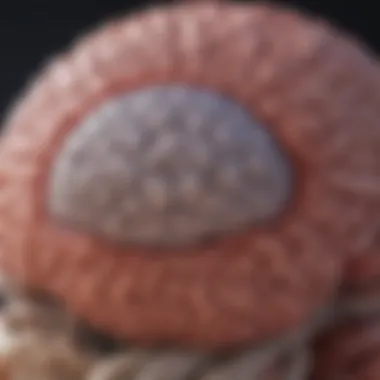Understanding Left Frontal Convexity Meningioma Symptoms


Intro
Left frontal convexity meningiomas are a specific type of brain tumor located on the outer surface of the brain. These tumors arise from the meninges, the protective membranes that cover the brain and spinal cord. Although meningiomas can occur in various locations, left frontal convexity meningiomas have unique clinical presentations that warrant careful examination.
Understanding the symptoms associated with this condition is essential for early diagnosis and effective treatment. Symptoms can range from cognitive changes to neurological deficits, affecting the patient's daily life and overall well-being. Knowing what signs to look for can help inform medical decisions and guide further investigation.
This article explores in detail the symptoms, diagnostic procedures, potential complications, and treatment options related to left frontal convexity meningiomas. By systematically dissecting these aspects, we aim to provide a comprehensive understanding of this particular subtype of meningioma.
Methodology
Study Design
To gain insights into the symptoms and implications of left frontal convexity meningiomas, a qualitative analysis of existing literature and case studies was conducted. This approach allowed for the assessment of various clinical manifestations reported in medical records and publications.
Data Collection Techniques
Data was collected using the following methods:
- Review of published journal articles focusing on case studies related to left frontal convexity meningiomas.
- Analysis of patient reports to understand presented symptoms.
- Consultation of expert opinions in neurology and oncology to gather insights on diagnostic approaches and treatment outcomes.
Discussion
Interpretation of Results
The results derived from the analysis highlight several common symptoms associated with left frontal convexity meningiomas. These include:
- Cognitive impairments, such as memory loss and difficulties in attention.
- Personality changes, which may manifest as altered behavior.
- Motor weaknesses on the right side of the body due to the specific location of the tumor.
These symptoms can significantly impact the quality of life and necessitate timely medical intervention.
Limitations of the Study
One limitation of this analysis is the variability in symptom presentation among patients. Not all individuals will experience the same signs, making it challenging to establish a standard profile. Moreover, the sample size of available case studies may not fully represent the broader population of affected individuals.
Future Research Directions
Future research should focus on larger-scale studies to establish more definitive symptom profiles for those affected by left frontal convexity meningiomas. Additionally, exploring novel diagnostic tools and treatment approaches could enhance outcomes and provide better support for patients.
A comprehensive understanding of the symptoms of left frontal convexity meningiomas is crucial for developing effective treatment strategies.
By consolidating existing research and patient data, this article provides valuable insights into the clinical manifestations of these tumors, which can aid both practitioners and researchers in their quest to improve health outcomes.
Prelude to Meningiomas
Meningiomas are a prevalent type of brain tumor arising from the meninges, the protective layers surrounding the brain and spinal cord. Analyzing their significance aids in understanding the myriad symptoms that can emerge, particularly when considering left frontal convexity meningiomas. This understanding is crucial for medical professionals and researchers exploring the clinical impacts of meningiomas and their management strategies.
Definition and Classification
Meningiomas are classified based on their location, histological characteristics, and WHO grading system. Most meningiomas are benign (grade I), presenting low recurrence risks post-resection. However, atypical and malignant meningiomas, classified as grade II and III respectively, require more aggressive treatment and close monitoring.
Epidemiology
These tumors account for approximately 36% of all primary brain tumors, with a higher incidence in females than in males. They are most often diagnosed in adults aged between 40 and 70 years. Knowing the epidemiological data helps to identify specific risk factors and tailor preventive strategies.


Pathophysiology
Meningiomas often arise due to a combination of genetic predisposition and environmental factors. The most significant genetic alteration detected in meningiomas is in the NF2 gene. Understanding the pathophysiological mechanisms underlying these tumors provides insight into their behavior, potential symptoms, and treatment options.
Location of Left Frontal Convexity Meningiomas
The location of left frontal convexity meningiomas holds significant importance in understanding this type of brain tumor. The precise location determines various aspects, including the symptoms exhibited, the potential for complications, and the implications for treatment. When meningiomas occur in the left frontal convexity, they may interact closely with surrounding structures in the brain, subsequently influencing the clinical outcomes observed in patients. Therefore, grasping the anatomical and functional context of this location is essential for effective diagnosis and management.
Anatomical Considerations
Left frontal convexity meningiomas are generally situated on the outer surface of the brain. This area is responsible for several key functions, including movement, attention, and higher cognitive processes. The proximity of these tumors to crucial areas in the frontal lobe can lead to a varied presentation of symptoms.
In a more anatomical sense, the left frontal convexity does not exist in isolation.
- It is framed by both the lateral sulcus and the central sulcus.
- Neighboring areas include the prefrontal cortex, which is vital for personality and decision-making.
- Also, it is near to regions involved in language processing, particularly in left-handed individuals.
The tumor's size and growth pattern may directly influence the level of brain function impairment experienced by patients. Thus, detailed imaging studies are critical for accurately assessing the tumor and planning appropriate interventions.
Impact on Adjacent Structures
The impact of left frontal convexity meningiomas on adjacent structures can not be underestimated. Due to their specific location, these tumors can exert pressure on vital brain components, leading to various neurological symptoms. Consequences may include:
- Disruption of cortical functions: Depending on the specific area under pressure, patients might notice memory issues, behavioral changes, or even alterations in speech.
- Effects on motor function: If the tumor affects areas associated with movement, patients may experience weakness or coordination difficulties, commonly seen in the extremities on the opposite side of the body.
- Seizure activity: The irritation caused by adjacent structures being compressed can lead to seizures, a symptom not uncommon in cases of left frontal convexity meningiomas.
Understanding the relationship between the tumor and its surrounding structures helps inform both the prognosis and treatment options for patients. A focus on these factors is central to the overall assessment of complications and the tailoring of therapeutic strategies, ensuring that intervention is not just effective but also safe.
Common Symptoms of Left Frontal Convexity Meningiomas
Understanding the common symptoms of left frontal convexity meningiomas is critical for early recognition and treatment. These tumors can present with varied clinical manifestations which may significantly impact an individual’s quality of life. Identifying symptoms early can lead to timely diagnosis, appropriate intervention, and better prognosis. The following sections will examine specific symptoms such as cognitive impairment, behavioral changes, headaches, focal neurological deficits, and seizures. Each symptom plays a distinct role in how the tumor affects the patient.
Cognitive Impairment
Cognitive impairment is often one of the earliest signs associated with left frontal convexity meningiomas. This impairment may present as difficulties in memory, attention, and executive functions. Patients may experience a decline in their ability to process information, which can lead to confusion and difficulty in performing daily tasks. The left frontal lobe is involved in language and analytical thought. Therefore, issues in this area can manifest as problems with language fluency or word retrieval. The gradual onset of these cognitive changes may be initially overlooked, but they are key indicators of underlying pathology that requires medical attention.
Behavioral Changes
Behavioral changes are another significant symptom that may arise from left frontal convexity meningiomas. Patients may exhibit alterations in personality or mood, changes in social interactions, and increased impulsivity. Such symptoms can be challenging for both the individual and family members as they can confuse the diagnosis with mental health issues rather than neurologic conditions. It is essential to consider these changes within the context of their neurological origin, as behavioral symptoms can provide valuable insights into the extent of the tumor’s impact on the brain function.
Headaches
Headaches associated with left frontal convexity meningiomas may be persistent and progressive in nature. Initially, headaches may be intermittent and easily managed. However, as the tumor grows, the headaches may become more severe or frequent. Patients often describe these headaches as pressure-like or throbbing. They can also be exacerbated by sudden movements or changes in position. This symptom warrants serious consideration, as it may indicate increased intracranial pressure or tumor growth that demands further evaluation.
Focal Neurological Deficits
Focal neurological deficits may occur due to compression of adjacent brain structures. These deficits may vary depending on the exact location of the tumor. Common deficits can include weakness on one side of the body, difficulties with coordination, or problems related to speech. These symptoms can signify involvement of specific neurological pathways that are critical for motor and sensory functions. Timely recognition of these deficits can aid in the assessment of the tumor’s impact and inform treatment strategies.
Seizures
Seizures can be a prominent symptom for some patients with left frontal convexity meningiomas. These seizures may present as focal seizures, which can affect one part of the body or involve specific movements or sensations. In some cases, seizures may generalize, leading to loss of consciousness. The presence of seizures indicates irritability of the cortical tissue, potentially resulting from the tumor's growth or pressure. Thus, when patients report a new onset of seizures, it is crucial to conduct thorough examinations to determine the underlying cause.
Early identification and management of symptoms related to left frontal convexity meningiomas can significantly influence treatment outcomes and patient quality of life.
Diagnosis of Left Frontal Convexity Meningiomas


The diagnosis of left frontal convexity meningiomas is crucial in the management and treatment of this type of brain tumor. A comprehensive understanding of diagnostic techniques not only aids in confirming the presence of a meningioma but also helps in evaluating its size, location, and any impact on surrounding tissues. Early and accurate diagnosis is key in formulating an effective treatment plan and can significantly influence the prognosis of patients.
Imaging Techniques
Magnetic Resonance Imaging
Magnetic Resonance Imaging (MRI) plays a defining role in the diagnosis of left frontal convexity meningiomas. It provides detailed images of brain structures, making it possible to visualize the tumor's characteristics and its relationship with adjacent tissues. The principal advantage of MRI over other imaging modalities is its sensitivity in detecting soft tissue masses.
MRI has a high-definition capability that enables better differentiation of tissue contrast, which is essential in identifying the meningioma's precise location. Furthermore, it is non-invasive and does not involve ionizing radiation, making it a safer option for repeated examinations.
However, the interpretation of MRI requires skilled radiologists, as nuances in images can be subtle. The unique feature of MRI is its ability to use contrast agents, which enhances visualization and can reveal important details about the tumor’s nature, such as edema or vascularity. Despite its many benefits, one should be aware of its limitations, such as prolonged scan times and increased cost compared to other imaging techniques.
Computed Tomography
Computed Tomography (CT) serves as another essential tool for diagnosing left frontal convexity meningiomas. CT scans are often the first-line imaging studies conducted when a brain tumor is suspected. The key characteristic of CT is its speed; it provides rapid results, which is crucial in emergency situations where time is of the essence.
CT scans provide excellent visualization of bone structures and can help evaluate any associated changes in the skull morphology due to the tumor. One unique feature of CT is its ability to detect calcium deposits within the tumor, which can be instrumental in differentiating meningiomas from other types of brain lesions.
However, CT is less sensitive than MRI in visualizing soft tissue components, which might lead to missed diagnoses or misinterpretations. Additionally, it exposes patients to radiation, making repeated scans less favorable. For comprehensive evaluation, a combination of both CT and MRI might be necessary to ensure thorough assessment of the lesion.
Histopathological Evaluation
Histopathological evaluation is critical following imaging diagnosis. It provides definitive confirmation of the tumor type through tissue sampling. A biopsy may be performed during surgical procedures or through stereotactic methods. Understanding the cellular makeup of the tumor helps in determining the appropriate treatment strategy and assessing potential malignancy. Furthermore, histopathological analysis can reveal genetic mutations which are relevant for prognosis and targeted therapies.
Potential Complications
The study of potential complications arising from left frontal convexity meningiomas is crucial for understanding the broader impact these tumors have on patient health. These complications not only affect the immediate survival chances of the patient but also their quality of life in both the short and long term. By exploring these complications, healthcare professionals can devise appropriate management strategies and guide treatment decisions effectively.
Increased Intracranial Pressure
One major complication of left frontal convexity meningiomas is increasing intracranial pressure (ICP). This condition occurs when the volume of the cerebrospinal fluid, blood, or brain tissue in the skull exceeds normal levels. The meningioma, depending on its size and location, can occupy space and contribute to this rise in pressure. Elevated ICP may manifest through various symptoms such as headache, nausea, vomiting, and in severe cases, altered consciousness.
Understanding how increased ICP can lead to irreversible brain damage underscores the urgency in diagnosing and managing these tumors promptly. Immediate interventions can include medications such as corticosteroids to reduce inflammation and diuretics to decrease fluid volume.
Neurological Damage
Another significant concern is the potential for neurological damage. Given the critical functions associated with the frontal lobe, a tumor in this region can lead to deficits in motor skills, language, and cognitive functions. Symptoms can vary widely, depending on how the tumor interferes with neighboring brain structures. A patient might experience weakness on one side of the body, difficulties with speech or understanding language, and changes in personality or behavior.
Neurological damage can also result from surgical interventions meant to remove the tumor. Thus, careful planning and evaluation are paramount to minimizing risks while maximizing the potential for recovery.
Recurrence Rates
When considering left frontal convexity meningiomas, the issue of recurrence rates cannot be overlooked. Although many patients can achieve good outcomes post-surgery, there is always a risk that the tumor may return. Studies show that tumor characteristics such as size, histological grade, and whether the entirety of the tumor was resected play pivotal roles in recurrence rates.
Monitoring through regular follow-up imaging is essential after treatment, as early detection of recurrence can lead to timely intervention. Patients should be informed of this possibility and made aware of the importance of ongoing assessments to ensure their wellbeing.
Understanding the potential complications associated with left frontal convexity meningiomas is vital for making informed clinical decisions and optimizing patient care.
Treatment Options
The treatment options for left frontal convexity meningiomas play a crucial role in managing this condition. Each approach must be tailored to the individual patient based on specific factors including the tumor’s size, location, and symptoms. A multidisciplinary team often evaluates these elements to devise the safest and most effective treatment plan. This section will outline the primary treatment avenues, which include surgical interventions and adjuvant therapies, providing a framework to understand their importance in achieving optimal outcomes.
Surgical Interventions


Indications for Surgery
Surgery is often recommended for left frontal convexity meningiomas when the tumor is causing significant symptoms or if it is growing rapidly. The key characteristic of indications for surgery is the potential for complete tumor resection. Achieving this can greatly reduce the chances of recurrence and alleviate associated symptoms like headaches and neurological deficits. Detailed imaging typically guides the decision to operate.
The unique feature of these indications lies in their focus on the impact of the tumor on the patient’s quality of life. A beneficial aspect of surgical intervention is that, when successful, it can lead to immediate relief from symptoms and prevent further complications. However, risks such as neurological damage must be considered, which may arise depending on tumor location.
Surgical Techniques
There are several surgical techniques used to remove left frontal convexity meningiomas. Craniotomy is the most common approach, allowing direct access to the tumor. The key characteristic of this technique is its ability to provide a clear visual of the tumor's structure and surrounding tissues. This facilitates a more effective resection, which is essential for reducing the risk of recurrence.
One notable feature of surgical techniques is the use of intraoperative imaging, which helps the surgeon identify tumor margins during the procedure. The advantages include improved resection rates and lower recurrence likelihood. Nevertheless, surgical procedures carry inherent risks, including infection or excessive bleeding, which must be openly discussed with patients.
Adjuvant Therapies
Adjuvant therapies are used in conjunction with surgical interventions to enhance treatment outcomes for left frontal convexity meningiomas. These therapies are vital in cases where complete tumor resection is not feasible or when the tumor showcases aggressive features.
Radiation Therapy
Radiation therapy is a common adjuvant treatment. It is often utilized to target residual tumor cells post-surgery. A key characteristic of radiation therapy is its non-invasive nature, which provides a method of controlling tumor growth without the need for further operations. The therapeutic advantage is the ability to minimize the chance of recurrence while preserving surrounding healthy brain tissue.
One unique aspect of this therapy is stereotactic radiosurgery, which delivers precise radiation doses to the tumor, reducing treatment time and associated risk. However, it can have delayed side effects, such as fatigue or skin irritation, which patients should consider before proceeding.
Chemotherapy
Chemotherapy may be considered in specific cases, especially for high-grade meningiomas or when other treatments fail. It is less commonly used than surgery or radiation therapy. The key feature of chemotherapy revolves around its systemic approach, targeting cancerous cells throughout the body. This option can provide valuable treatment for tumors that are not amenable to surgical excision.
One of the advantages of chemotherapy is its ability to address multifocal disease, which is beneficial in specific contexts. However, it is important to acknowledge the potential disadvantages, such as side effects that can impact overall well-being and quality of life.
In summary, treatment options for left frontal convexity meningiomas involve a coordinated approach that prioritizes the patient’s needs and overall health. By combining surgical and adjuvant therapies, healthcare professionals strive to achieve effective management of this complex condition, balancing efficacy with potential risks.
Prognosis and Quality of Life
Understanding the prognosis and quality of life for patients with left frontal convexity meningiomas is crucial. This topic encompasses survival rates, long-term effects of treatments, and how the disease impacts daily living. Given that these tumors can affect not only physical health but also cognitive and emotional well-being, an appreciation of prognosis can significantly guide treatment choices and management strategies.
Survival Rates
Survival rates are a cornerstone in prognosis. For patients diagnosed with left frontal convexity meningiomas, the five-year survival rate is generally favorable, often exceeding 80%. However, the rates can vary based on several factors:
- Tumor Size: Larger tumors may present more surgical challenges and have a higher likelihood of recurrence.
- Histological Type: Some types of meningiomas, like atypical meningiomas, show different behaviors than their benign counterparts.
- General Health: The patient’s overall health and any coexisting medical conditions can also influence outcomes.
It is essential that patients discuss their specific cases with healthcare professionals to garner insight into individual survival probabilities. This information can aid in making informed decisions about treatment and lifestyle adjustments.
Long-term Monitoring
Long-term monitoring is essential after treatment. Patients often undergo regular follow-ups that include imaging studies to check for any signs of recurrence. This is especially important considering that meningiomas can sometimes recur many years after initial treatment. Key components of long-term monitoring include:
- Regular Imaging: Patients may have periodic magnetic resonance imaging (MRI) or computed tomography (CT) scans.
- Neurological Assessments: Evaluating cognitive function and neurological health helps identify any changes that might require intervention.
- Supportive Care: It is important to address any persistent symptoms through therapy or rehabilitation programs, especially in cognitive or emotional domains.
"Effective monitoring strategies are pivotal for managing long-term outcomes for patients with left frontal convexity meningiomas."
Patients should actively engage with their healthcare providers to establish a follow-up plan tailored to their needs. This proactive approach not only aims to improve prognosis but also enhances overall quality of life, allowing individuals to adapt to ongoing health challenges and maintain independence as much as possible.
Epilogue
First, awareness of symptoms such as cognitive impairment, behavioral changes, and neurological deficits can lead to timely diagnoses. Early recognition of these symptoms is crucial for treatment planning and ultimately, can improve the overall prognosis for the patient. Additionally, patients’ quality of life can greatly benefit from proactive management of these symptoms.
Second, the article stresses the impact of left frontal convexity meningiomas on adjacent structures. Understanding this can aid in predicting potential complications and help neurologists or neurosurgeons devise effective approaches to surgery or other treatments. This makes multidisciplinary collaboration more vital in the care of patients with meningiomas.
Finally, continuous education and research into this subtype of meningioma can offer new insights and unfold better therapeutic avenues. As medical knowledge advances, so does the potential for enhanced survival rates and improved patient outcomes. By continually fostering a deeper understanding of left frontal convexity meningiomas, we ensure that both current and future patients receive informed and effective care.
To summarize, recognizing the symptoms of left frontal convexity meningiomas is a pivotal aspect of improving diagnosis, treatment, and overall health outcomes for affected individuals.







